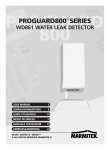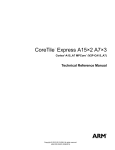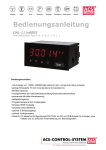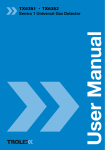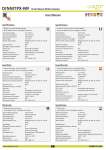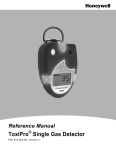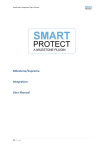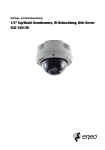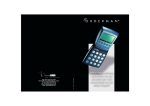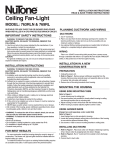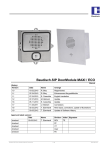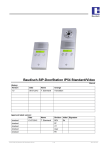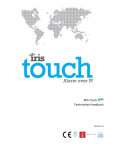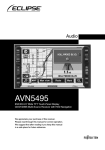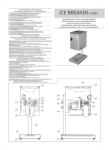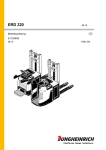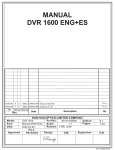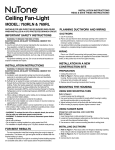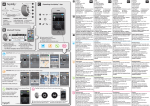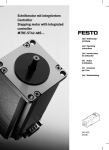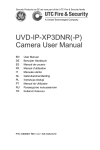Download RFID Module Manual
Transcript
Baudisch.Transponderleser ID6 Manual History: Version 1.0 Date Name Change 27.06.2012 T. Eberhardt Translation Name Division Initial Signature T. Eberhardt DEV Approval latest version Date checked 27.06.2012 checked PF checked VT checked User checked FE 20120627EB_HB_Transponderleser_ID6-EN.doc 1 / 27 Eb Eb/27.06.2012 Baudisch.Transponderleser ID6 Version: 1.0 - As of: 27.06.2012 1. Table of Content 1. Table of Content ............................................................................................................................ 2 2. General Information ....................................................................................................................... 3 2.1. Symbols ......................................................................................................................................... 3 2.2. Software History ............................................................................................................................ 3 2.3. Hardware Versions ........................................................................................................................ 4 3. Product Description ....................................................................................................................... 5 3.1. General Information ....................................................................................................................... 5 3.2. Abridgment .................................................................................................................................... 6 3.3. Details ............................................................................................................................................ 8 3.4. Accessories ................................................................................................................................. 11 4. Connection and Installation ......................................................................................................... 15 4.1. 4.1.1. 4.1.2. Connectors .................................................................................................................................. 15 ID6-JV-E, ID6-JV and ID6-Steel .................................................................................................. 15 ID6-RL ......................................................................................................................................... 16 4.2. 4.2.1. 4.2.2. Solder bridges.............................................................................................................................. 16 ID6-JV-E, ID6-JV and ID6-Steel .................................................................................................. 17 ID6-RL ......................................................................................................................................... 17 4.3. Front Panel Mounting type ID6-JV-E and ID6-JV........................................................................ 17 4.4. 4.4.1. 4.4.2. 4.4.3. 4.4.4. 4.4.5. 4.4.6. 4.4.7. EasyLAN data bus ....................................................................................................................... 19 Basic Principle ............................................................................................................................. 19 Selection of Wires........................................................................................................................ 19 Length of Wires............................................................................................................................ 19 Wiring Architecture ...................................................................................................................... 19 Data Format................................................................................................................................. 19 Bus Subscriber Addressing ......................................................................................................... 20 File Transfer Process................................................................................................................... 20 5. Software Logic ............................................................................................................................. 21 5.1. 5.1.1. 5.1.2. Transponder ................................................................................................................................ 21 Functions ..................................................................................................................................... 21 Data Content................................................................................................................................ 22 5.2. Teach-in Mode............................................................................................................................. 22 5.3. Presence Logic ............................................................................................................................ 23 5.4. Remote Control of the LEDs........................................................................................................ 23 5.5. Input States.................................................................................................................................. 24 6. Configuration Parameter ............................................................................................................. 25 20120627EB_HB_Transponderleser_ID6-EN.doc 2 / 27 Eb/27.06.2012 Baudisch.Transponderleser ID6 Version: 1.0 - As of: 27.06.2012 2. General Information 2.1. Symbols Warning of dangerous electrical voltage. This symbol points out important references, which must be followed to avoid injuries, as well as damages and malfunctions of the product. This symbol points out helpful references. 2.2. Software History Date Version Description / Function Expansion 20.12.2005 Initial Version. 30.05.2006 1.0 1.1 09.09.2006 1.2 RX-Uart Function improved. 24.03.2007 1.3 Add-on: Parity Check EasyLAN added. • Reset of A1 and A2 by Transponder 55558 • Separate parameter for time slot S2 and continuous operation, new parameter 9, both adjustable in 0,5 sec steps • Editing of the access list by EasyLAN bus. • Telegram repeats to target address adjustable by parameter 0x0B. 24.04.2007 1.4 23.05.2007 1.5 New parameter 12, switching of the relays and the green LED after adjusted time (in seconds) to use the ID6 without bus connection. 05.10.2007 1.6 Telegram extension C4-02-00-8x to identify the state of the 4 LEDs. 05.12.2007 1.7 Switching to state presence 2, if parameter 12 is activated. 11.04.2008 1.8 EMC test mode added, porting to ICC V7.X, EEPROM mapping adapted. 25.04.2008 1.9 Digital inputs and reaction masks, EasyLAN bit masks extended, status signal and transmit check added. Calibration Byte in EEPROM changed from address 2 to 32. Not relevant for the usability. 20120627EB_HB_Transponderleser_ID6-EN.doc 3 / 27 Eb/27.06.2012 Baudisch.Transponderleser ID6 Version: 1.0 - As of: 27.06.2012 07.05.2008 2.0 Reaction masks have priority to the internal LED switch off. 08.05.2008 2.1 Test mode extended, start by special transponder chip. 03.06.2008 2.2 Bug fix: Handling of red LED, when transponder chip is in detection range 22.01.2009 2.3 Bug fix: Internal Pull-ups for inputs (hardware option). 09.08.2010 2.4 EasyLAN bug fix (TX handler) added, new EEPROM parameter for light switch in context with A1 and A2. New parameter to handle state presence 1 and presence 2 separately. 06.09.2010 2.5 Bit7 of parameter 10 (0x0A) has now a function: Both green LEDs illuminated, if state presence 1 is activated. 15.08.2011 2.3. 2.6 Handling of data packet and timer message in case of receive of switch command at once. Hardware Versions Date Version Expansion 10.06.2010 0.1 Initial Version 23.09.2010 1.3 Improvement of the power supply (several modules connected to one Door Module). 20120627EB_HB_Transponderleser_ID6-EN.doc 4 / 27 Eb/27.06.2012 Baudisch.Transponderleser ID6 Version: 1.0 - As of: 27.06.2012 3. Product Description 3.1. General Information The vandalism protected transponder reader with self-sufficient key switch function and a optional data bus connector for central configuration or function control was developed to detect the presence of attendants in a hall of a prison. Compared to well-established procedures based on PIN numbers, terminals or mechanical keys, the transponder technology opens up important advantages. • The detection of a transponder is contactless, so there is no wear. • The reading operation is completed in a very short time and the key number is transmitted securely. • The needs no electricity, so you can carry it on your bunch of keys. • In case of loss or damage a transponder can get prohibited and replaced by another one. In condition of delivery each transponder is programmed to an individual key number. The transponder communicates by a weak magnetic field with a few centimeter of range with the reader. If there is a transponder in the magnetic field, there is automatically a transmission of the data to the reader. The reader detects the number and starts directly with programmed switching functions or transmits the number together with it’s own code to a central unit. • Up to 3 states and visualization with integrated LEDs. • Visualization of presence in the hall. • Cancellation of a prison cell call. • Preparation of an officer’s alert (type ID6-JV) after activation 1 or timeout after activation 2. • Compelled power-on of the cell electric lighting (type ID6-JV). • Access control and door release with online link. • Time posting “arriving – leaving – business trip” in conjunction with a data connection to a central unit. 20120627EB_HB_Transponderleser_ID6-EN.doc 5 / 27 Eb/27.06.2012 Baudisch.Transponderleser ID6 Version: 1.0 - As of: 27.06.2012 3.2. Abridgment Item number Name Description 36-0147E Transponder reader ID6-JV-E Transponderleser ID6-JV-E Basic version without sabotage Basis-Version ohne Sabotageschutz protection with covering panel in mit Abdeckplatten aus eloxiertem anodized aluminum. Alu. Transponder reader ID6-JV Transponderleser ID6-JV JVA version with sabotage contact JVA-Version mit Sabotagekontakt und and V2A covering. Shows status V2A-Abdeckung. Zeigt die Zustände presence 1 and 2. Anwesenheit 1 und 2 an. Transponder reader ID6-EA Transponderleser ID6-EA Transponder reader with 2 digital Transponderleser mit 2 digitalen inputs instead of an sabotage Eingängen anstelle switch. V2A covering, 2 relay Sabotageschalter. V2A-Abdeckung, 2 outputs. Relais-Ausgänge 36-0147 36-0185 20120627EB_HB_Transponderleser_ID6-EN.doc 6 / 27 Eb/27.06.2012 Baudisch.Transponderleser ID6 Version: 1.0 - As of: 27.06.2012 Item number Name Description 36-0183 Transponder reader ID6-RL Transponderleser ID6-RL Transponder reader for outdoor Transponderleser für Anwendungen im operations. 2 digital inputs, V2A Außenbereich. 2 digitale Eingänge, covering, 2 relay outputs. 2 Relais-Ausgänge, V2A-Abdeckung. Transponderschalter ID6-Steel Transponderschalter ID6-Steel Vandal-protected transponder reader Vandalismusgeschütztes module with Baudisch.EasyLAN data Transponder-Lesemodul mit bus terminal. Baudisch.EasyLAN Datenbusklemme zur 33-1197 Anbindung an zentrale Komponenten der Baudisch Zugangskontrolle oder Zeiterfassung. 20120627EB_HB_Transponderleser_ID6-EN.doc 7 / 27 Eb/27.06.2012 Baudisch.Transponderleser ID6 Version: 1.0 - As of: 27.06.2012 3.3. Details Transponderleser ID6-JV-E (Art.-Nr. 36-0147E) Vandalism protected transponder reader with selfsufficient key switch function and optional data bus connector for a central configuration or function check. Built-in mounting in in-wall pattress box diameter 61mm. Depth measured from rear side of the mounting panel approx. 42mm. Mounting panel with stainless steel cover approx. 80x80x6mm. V2A safety screws. Power supply 24VDC, 50mA. 1 Open Collector Output (80V, 15W, max. 250mA) for electric lighting control. 2 multicolor LED indicators (red / green / yellow). Acoustic function indicator available for all states if the device like alert sound generation. Safe detection of the transponder in a range up to 10mm. Internal storage for 5000 keys or groups. General erasure of all authorities, selective adding or deleting of keys or groups by configuration transponder. Individual erasure of lost transponders by configuration transponder and master program unit. Data bus interface for connection to central unit and separate indicators. Configuration with optional Windows software, also in mounted state by data bus connection. 20120627EB_HB_Transponderleser_ID6-EN.doc 8 / 27 Eb/27.06.2012 Baudisch.Transponderleser ID6 Version: 1.0 - As of: 27.06.2012 Transponderleser ID6-JV (Art.-Nr. 36-0147) Vandalism protected transponder reader with selfsufficient key switch function and optional data bus connector for a central configuration or function check. Characteristics as ID6-JV-E, but addiotional features: • Electrical sabotage protection, acting if front panel is removed. • Upper front panel consists of stainless steel V2A, lower panel of anodized aluminum. Due to the V2A front panel and the sabotage protection, this device fulfills a higher safety standard than the base version. The software and configuration is the same as at ID6JV-E. Transponderleser ID6-EA (Art.-Nr. 36-0185) Vandalism protected transponder reader with selfsufficient key switch function and optional data bus connector for a central configuration or function check. Characteristics as ID6-JV-E, but addiotional features: • Upper front panel consists of stainless steel V2A, lower panel of anodized aluminum. • 2 digital inputs, galvanic isolation by optocouplers. Working from 12V to 24V DC. The digital Inputs may generate several sounds depending on the software configuration. The state of the inputs can be sent to the central unit. 20120627EB_HB_Transponderleser_ID6-EN.doc 9 / 27 Eb/27.06.2012 Baudisch.Transponderleser ID6 Version: 1.0 - As of: 27.06.2012 Transponderleser ID6-RL (Art.-Nr. 36-0183) Vandalism protected transponder reader with selfsufficient key switch function and optional data bus connector for a central configuration or function check. Characteristics as ID6-JV-E, but addiotional features: • Upper front panel consists of stainless steel V2A, lower panel of anodized aluminum. • 2 digital inputs, galvanic isolation by optocouplers. Working from 12V to 24V DC. • Coating of the printed circuit board to avoid damages through high himidity. • Extended temperature range. • No speaker This ID6 can be used in conjunction with a mast housing as shown in the illustration. Transponderschalter ID6-Steel (Art.-Nr. 33-1197) Transponder reader with Baudisch.EasyLAN data interface for connection to a central unit for access control and time recording. Mounting in ModularSteel-System. Power supply 24VDC, 50mA. 1 Open Collector Output (80V, 15W, max 250mA) for electric lighting control. 2 multicolor LED indicators (red / green/ yellow). Acoustic function indicator available for all states if the device like alert sound generation. Safe detection of the transponder in a range up to 10mm. Internal storage for 5000 keys or groups. The shown front panel has to be ordered separately. 33-1176 V4A front panel for ID6-Steel General erasure of all authorities, selective adding or deleting of keys or groups by configuration transponder. Individual erasure of lost transponders by configuration transponder and master program unit. Data bus interface for connection to central unit and separate indicators. 109,5 x 109,5 x 2mm Configuration with optional Windows software, also in mounted state by data bus connection. 20120627EB_HB_Transponderleser_ID6-EN.doc 10 / 27 Eb/27.06.2012 Baudisch.Transponderleser ID6 Version: 1.0 - As of: 27.06.2012 3.4. Accessories Konfigurationskit ID6-JV (Art.-Nr. 36-0147X) The configuration kit ID6 is used to program the transponder chips and consists of a PC software (Windows 98, XP) and a programming device. Scope of delivery: • Windows Software ID6-PROG with manual (CD-ROM) • Programming device for connection to a PC RS232 (COM1-COM4). • Wall power supply • 5 transponder chips IC6-CP-RD (red configuration transponder) Scope of operation: Detection and display of the data content of all transponder chips (if there is no labeling) Programming of the functions of configuration transponders. Each configuration transponder can be used for one of these functions: - Deleting of a defined chip number (1 to 5000). The number is programmed to the chip. - Activating/deactivating of the teach-in mode of a transponder reader. - Deleting all of the 5000 authorities. - Activation of all of the 5000 authorities. - Reset of the Transponderlesers. 20120627EB_HB_Transponderleser_ID6-EN.doc 11 / 27 Eb/27.06.2012 Baudisch.Transponderleser ID6 Version: 1.0 - As of: 27.06.2012 Transponder Schlüsselanhänger schwarz / blau / rot (Art.-Nr. 31-0503, 31-0503R, 310503B) Transponder keys for a contactless operation of the ID6. Programmed with a safe 64 bit number, containing system ID, customer ID and lock information. Standard functional chain: A1 - A2 - Light - not active Color: black Programmed serial, Label with key number • Available colours: o 31-0503 black / grey o 31-0503R red / grey o 31-0503B blue / grey Each RFID product and it’s number is listed in a safe data base in the factory. So it’s sure that each device is individual programmed. When ordering, you have to name one of these three functions: • Standard use: Triggering of a door release buzzer or access permision. • Prison presence logic: standard switching chain A1 - A2 - Light - not active • Electrical lighting: Switchs on the output as long as the transponder is present in the detection range. Measures of the transponder chip: Diameter 31mm, max. 40mm You can not order the transponder chips separately, you always have to tell us a corresponding project. 20120627EB_HB_Transponderleser_ID6-EN.doc 12 / 27 Eb/27.06.2012 Baudisch.Transponderleser ID6 Version: 1.0 - As of: 27.06.2012 Transponder Schlüsselanhänger rot Special functions for transponder reader ID6 (Art.-Nr. 31-0503S, 31-0503P, 310503C, 31-0503F, 31-0503Z) The designated function must be communicated with each order: • 31-0503S Erasing of a spezific key number (1 to 5000) • 31-0503P Configuration transponder switchs on and off the teach-in mode of the ID6 • 31-0503C Locks all transponder chips of a system (1 bis 5000). • 31-0503F Unlocks all transponder chips (1 bis 5000). • 31-0503Z Resets the presence state of a transponder reader All items delivered as a key pendant in red / grey. Measures of the transponder chip: Diameter 31mm, max. 40mm You can not order the transponder chips separately, you always have to tell us a corresponding project. Sektionalanzeige ID6-JDP (Art.-Nr. 36-0177) Indication of the state of up to 32 transponder reader ID6 in LED technology. Labeling of numbers or names with inlays possible. State A1: illuminated green State A2: flashing green (slow) Time alert: flashing green (fast) Simple wiring of the transponder reader by 2 wire bus in any architecture. On-wall or in-wall mounting. Power supply 24V DC, max. 700mA. 20120627EB_HB_Transponderleser_ID6-EN.doc 13 / 27 Eb/27.06.2012 Baudisch.Transponderleser ID6 Version: 1.0 - As of: 27.06.2012 ASB_2OutRelais (Art.-Nr. 36-0113) EasyLAN module comes with 2 relay outputs 48V / max. 10A for DIN rail mounting. Double relay module to transfer the relays state to the transponder reader ID6. Reduction of the amount of wires: All transponder reader can be connected by 2 wire bus in any architecture (additional wires for sabotage and supply necessary). Useful for switching state remote indicator. Two inputs for the connection of isolated switching contacts to remote control the light switching output as well as the speaker of the transponder reader ID6. Datenbus-Interface RS232 (Art.-Nr. 36-0101) RS232 converter with galvanic isolation for the connection of the EasyLAN 2 wire bus to a PC Remote monitoring of states and functions of up to 63 transponder reader ID6 per bus segment. Configuration of the transponder reader ID6 in conjunction with the Windows-Config-Software (WCS). Connection of the transponder readers to a facility management system with Open-Access-DDL. Remote control of all switching functions, the LED indicators and the speaker of the transponder reader in conjunction with the Windows-Remote-Software (WRS). There is a RS232 wire (length: 2m) and a kit for mounting the device on a DIN rail included in the delivery. Windows-Config-Software (WCS) Configuration of the transponder reader in conjunction with a RS232 data bus interface. Windows-Remote-Software (WRS) Remote control of all outputs, the LED indicators and the speaker of the transponder reader ID6 in connection with the RS232 data bus interface. 20120627EB_HB_Transponderleser_ID6-EN.doc 14 / 27 Eb/27.06.2012 Baudisch.Transponderleser ID6 Version: 1.0 - As of: 27.06.2012 4. Connection and Installation 4.1. Connectors 4.1.1. ID6-JV-E, ID6-JV and ID6-Steel Number Description 1 Power supply 24VDC/50mA 2 EasyLAN bus 3 0V (GND) 4 Open Collector Output (80V/15W, max. 250mA) 5 Isolated switching contact for sabotage 6 Isolated switching contact for sabotage 7 Isolated relay contact 1 8 Isolated relay contact 1 9 Isolated relay contact 2 10 Isolated relay contact 2 20120627EB_HB_Transponderleser_ID6-EN.doc 15 / 27 Eb/27.06.2012 Baudisch.Transponderleser ID6 Version: 1.0 - As of: 27.06.2012 4.1.2. ID6-RL 4.2. Number Description 1 Power supply 24VDC/50mA 2 EasyLAN bus 3 0V (GND) 4 Open Collector Output (80V/15W, max. 250mA) 5 Input 2 (0V) 6 Input 1 (0V) 7 Isolated relay contact 1 8 Isolated relay contact 1 9 Isolated relay contact 2 10 Isolated relay contact 2 Solder bridges The devices is in an operable when delivered. If the relay contacts should be galvanic isolated to each other, it is possible to configure by solder bridge. Also there can be uses a 10kOhm resistor in the sabotage loop option, which is used instead of the digital inputs E1 and E2. To detect the state of the sabotage switch is not supported by the software until now. 20120627EB_HB_Transponderleser_ID6-EN.doc 16 / 27 Eb/27.06.2012 Baudisch.Transponderleser ID6 Version: 1.0 - As of: 27.06.2012 4.2.1. ID6-JV-E, ID6-JV and ID6-Steel Solder Bridge closed open J1 Pin 8 is shared as a output of relay 1 default and relay 2, that means connector 8 is connected to 10. J2 Sabotage loop resistance 0 Ohm (default) 10kOhm J3, J7 Sabotage is reported to controller Sabotage state extern (default) Solder Bridge closed open J1 Pin 8 is shared as a output of relay 1 Relay contacts isolated to each other and relay 2, that means connector 8 is connected to 10. J6 Power supply of the inputs on connector 10 4.2.2. ID6-RL 4.3. Power supply of the inputs not connected to the connector Front Panel Mounting type ID6-JV-E and ID6-JV When mounting the stainless steel front panel keep in mind to mount it straight and with no application of a force until it seats solidly on the aluminum panel. Do not push the stainless steel panel up, so the stud bolt will operate the switch securely. ! Take care not to bend the switch when mounting the front panel. Figure 1: The stud bolt of the front panel operates the sabotage switch – the sabotage loop is closed. 20120627EB_HB_Transponderleser_ID6-EN.doc 17 / 27 Eb/27.06.2012 Baudisch.Transponderleser ID6 Version: 1.0 - As of: 27.06.2012 Figure 2: The front panel is pushed slanted above and inserted. The stud bold is pressed closed to the sabotage switch. Take care not to bend it, to avoid malfunctions. Figure 3: The stud bolt is inserted correctly, the sabotage switch is operated precise. Figure 4: This picture shows a bent switch and will lead into malfunction. Adjust it as shown in figure 1. 20120627EB_HB_Transponderleser_ID6-EN.doc 18 / 27 Eb/27.06.2012 Baudisch.Transponderleser ID6 Version: 1.0 - As of: 27.06.2012 4.4. EasyLAN data bus EasyLAN was developed by Baudisch Electronic GmbH to connect electronic systems and devices in an easy and safe way. The design allows the use of long unshielded wires to connect the devices. Also it is resistant to electrical damages. 4.4.1. Basic Principle The bus conductor is connected to positive voltage (+12V) in one device. So it is on high potential when in stand by mode. All bus subscribers are able to pull the bus conductor down to ground potential by a tough circuit to send data. The bus conductor is connected to the micro controller highly resistive and EMC protected. So the central processing unit is able to receive it’s own transmitted data and it’s able to compare it. Also it’s possible to interpret data from other bus subscribers. 4.4.2. Selection of Wires The easiest way to use EasyLAN is in 2 wire technology. In this case the wires are connected to ground and bus signal. All bus subscribers need a separate power supply with galvanic isolation (e.g. a wall wart). Usually EasyLAN is used in 4 wire 2x2x0,6² technology. The second pair of wires allows to bring the supply voltage (e.g. 12VDC) with the bus. So it is possible to power devices with a small power consumption by the bus wire. 4.4.3. Length of Wires The maximum length of wires depends on the used wires overall. Using a common shielded communication cable 2x2x0,6 there is a possible length up to 2km. High grade wires (e.g. green Instabus cable) are used for longer distances. The EasyLAN bus allows a capacity of up to 100nF and a maximum loop impedance of 100 Ohm. 4.4.4. Wiring Architecture It is not necessary to connect EasyLAN in star or loop architecture, it can be used any architecture. The most common way to install EasyLAN is to use one power supply for all ID6 readers. It is not allowed to install a bus segment larger than the power supply range, because EasyLAN has no galvanic isolation. Installing the bus from floor to floor will lead to a connection of different ground potential and leakage currents or ground loops. 4.4.5. Data Format The data format of the EasyLAN data bus is compatible to many asynchronous serial interfaces. EasyLAN can be converted via level converter to RS232 or RS422. There are corresponding devices available providing galvanic isolation and function indicators. (e.g. EasyLAN PCInterface). The data type is defined to 4800 Baud, 8 Bit, 2 Stop bit, Parity even 20120627EB_HB_Transponderleser_ID6-EN.doc 19 / 27 Eb/27.06.2012 Baudisch.Transponderleser ID6 Version: 1.0 - As of: 27.06.2012 4.4.6. Bus Subscriber Addressing The EasyLAN technology achieves an aim to give the possibility to send a message to a defined subscriber on the bus, if necessary. So each device needs it’s address to use it in the telegrams. One consequence is that the receiver confirms the reception. Any EasyLAN telegram includes a target address and the address of the sender. EasyLAN supports up to 64 logical bus addresses, shown in a data byte in the range from 40h to 7Fh. When assigning the addresses, the subscribers with top priority have the lowest address. It is important not to use an address several times. 4.4.7. File Transfer Process Previous to send a data telegram by a device, the device checks for a idle bus for itself. The duration of this check depends on the own address and will be restarted if the bus was busy. Afterwards a telegram like this will be sent: DST SRC STW LEN D0 .. Dn BCC CR The receiver sends an acknowledgement telegram, that has to be received within 250ms: DST SRC ACK A receiver must give a receipt for a telegram with a correct syntax, independent if the data content and the control command will lead into an activity. If there is no acknowledgement received, the telegram is sent again. Attention: In the acknowledge telegram DST means the address of the subscriber the telegram was sent from, SRC stands for the sender. 20120627EB_HB_Transponderleser_ID6-EN.doc 20 / 27 Eb/27.06.2012 Baudisch.Transponderleser ID6 Version: 1.0 - As of: 27.06.2012 5. Software Logic 5.1. Transponder 5.1.1. Functions The device discerns 8 different types of transponders with a different mode of operation. Type F-Identifier Key Number Description N 0x20 1 to 65535 Transponder for normal access control without further local logic. L 0x80 1 to 5000 Toggles the electrical Light um (on <-> off) A 0x81 1 to 5000 Changes the presence state (A): A0 -> A1 -> A2 -> A0 and so on. S 0x88 1 to 5000 Selective erase transponder Switches the teach-in mode on or off and erases by activating the teach-in mode the authority of the key with a specific number. This is used to delete a lost transponder chip. P 0x88 55555 Configuration transponder (Program) Switches the teach-in mode on or off. There are no further functions. C 0x88 55556 Erase transponder Clears the memory by switching on or off the teach-in mode and erases the authorities of all keys (numbers 1 to 5000). F 0x88 Formatting transponder: 55557 Switches on or off the teach-in mode and activates the authority of all keys (1 to 5000). R 0x88 Reset Transponder 55558 Restarts the software of the reader and clears saved presence states A1 or A2. T 0x88 Test mode activated. 55559 LEDs and relays toggle and sound plays depending on test mode configuration (see parameters). 20120627EB_HB_Transponderleser_ID6-EN.doc 21 / 27 Eb/27.06.2012 Baudisch.Transponderleser ID6 Version: 1.0 - As of: 27.06.2012 5.1.2. Data Content The following data fields are programmed to the transponder and will be sent to the reader: • Application ID • Object ID • Key number • Date code creation • Function detection • Check sum process 5.2. Application, use of the transponder, access control Differentiation of the end user is made dependent to the order. 2 Byte, adjustable from 1 to 65534 For the numbers 1 to 5000 there are can be authorities for direct switch functions. Day.Month.Year, each with two digits, for internal application or interpretation by the host. There is no influence to the switch authority. Two-digit Hex, declares the function of the transponder. For data safety during transfer. Teach-in Mode The teach-in mode allows to lock or unlock individual transponder chips in the authority list. To do so the corresponding transponder must be in the detection range while the teach-in mode is activated. • Teach-in mode on/off by configuration transponder (P): The tech-in mode is activated and disabled by using any transponder chip with function 0x88 (except chips for test mode) activated. When activating you will hear increasing tones, if deactivated you will hear decreasing sounds. While this mode is active, the red LEDs will be illuminated alternately (approx. 1 Hz). • Transponder tech-in/erase: The transponder will be activated in the active time period. So the state of clearance is changed and the following new state is shown acoustically. Tech-in and erase will alternate each time the chip is present. If the transponder is authorized, a positive signal will sound, if the chip is locked, a negative signal will sound. • You can only use teach transponder chips with function detection 0x80 (electrical lighting) and 0x81 (presence). • Time out: The tech-in mode stops automatically 60 seconds after activation or last teach-in. 20120627EB_HB_Transponderleser_ID6-EN.doc 22 / 27 Eb/27.06.2012 Baudisch.Transponderleser ID6 Version: 1.0 - As of: 27.06.2012 5.3. Presence Logic To control the presence state logic, transponder chips must be programmed with the function detection 0x81 and a key number from 1 to 5000. • If there is a locked transponder detected, a negative tone is generated and there is no switch operation. • To reset the states A1 and A2 you have to use the same chip as you used to set the states. • If there is an adjusted time out for state A1 (e.g. 10 seconds) the next transponder detection will reset the chain to A0. • If the reader is in state A0 and the transponder is in range longer than the adjusted time (e.g. 5 seconds) the reader is set to A0 when the chip is no longer present. With this function it is possible to control the electrical lighting as long as the chip is in front of the reader. • The indication of A1 is realized by the green LED with the Roman numeral 1, the indication of A2 with both LEDs. • In case A1 or A2 the output “light” is activated. • The contact A1 is closed, as long as the reader is in state A1 (transponder detected once). • The contact A2 is closed, as long as the reader is in state A2 (transponder detected twice). 5.4. Remote Control of the LEDs From software version 1.6 the 4 LEDs can be controlled by bus to indicate states in buildings. For example: Alarm system activated/not activated, doors locked/unlocked and so on. A bit mask, received by bus, defines the states with the 4 LEDs: Bit 0: Bit 1: Bit 2: Bit 3: LED green at the top LED red at the top LED green at the bottom LED red at the bottom After starting the software (reset) the state is zero, the LEDs are off. This indication is subordinated to internal functions of the reader. If there are other LED states set by a switch function, the software will add them to the current state. So the remote indication only works in stand-by state in the transmitted combination. 20120627EB_HB_Transponderleser_ID6-EN.doc 23 / 27 Eb/27.06.2012 Baudisch.Transponderleser ID6 Version: 1.0 - As of: 27.06.2012 5.5. Input States The two inputs can be used for several purposes. For example for indication of states (door open/closed/locked etc.). The table below shows how to realize an optical and/or acoustical indication depending on the inputs. The current state can be sent to a computer system if there is a bus connection. The state “on” signalizes the change from input active to inactive. The state “off” shows a change from input inactive to active. An input is active if there is an electrical voltage present and inactive if there is no voltage. ú Bit Reaction 0 LED red 1 on 1 LED red 1 off 2 LED green 1 on 3 LED green 1 off 4 LED red 2 on 5 LED red 2 off 6 LED green 2 on 7 LED green 2 off If there are two complementary bits set (e.g. red 1 on and red 1 off), the current state will toggle. The number of available sounds starts the acoustic reaction. The range from 00h to 7Fh can contain valid sound. Defined sounds (incl. FFh = 255d) are: 20120627EB_HB_Transponderleser_ID6-EN.doc 24 / 27 Eb/27.06.2012 Baudisch.Transponderleser ID6 Version: 1.0 - As of: 27.06.2012 6. Configuration Parameter The configuration of the device is stored in its EEPROM and can be changed by the corresponding EasyLAN messages. EEPROM address Default value Description 00h 0x00 Reserved for CPU 01h 0x55 Load factory default If this value is programmed unequal to 0x55, the device will load the factory default values after reset. 02h 0x00 Not in use. 03h 0x41 Own bus address. 04h 0x40 Target address (PC). 05h 0x1E Interval time state call in 10 seconds increments. 06h 0x?? Time to transponder clear call in 50ms increments. 0x3C = Default value EasyLAN transponder reader 0x08 = Default value JVA 07h 0x0C Time for minimal presence time in prison cell x 0.5 seconds. If there is between the activation on state A1 and the following transponder detection a larger time than adjusted with this parameter, the presence state is cleared at the upcoming chip detection. 08h 0x?? Clearance of EasyLAN send telegrams: Bit0: state message on power-on Bit1: periodic state message after time Bit2: message of transponder data Bit3: clear message after transponder detection Bit4: state message after changing presence state Bit5: state message after changing input Bit6: state transmit check activated / hardware state change generates a state message 0x0D = Default value EasyLAN transponder reader 0x00 = Default value JVA 09h 0x06 Time for detection long-term operation output A1 x 0.5 seconds. If there is more time elapsed between activation of A1 and the removal of the chip, presence 1 will be cleared when removing the chip. 0Ah 0x?? Clearance for options: Bit0: play sound after reset Bit1: acoustical indication of light switch chip Bit2: acoustical indication of switch state A0, A1, A2 Bit3: lock of switch state A2, if parameter 0Ch uneven 0 Bit4: field detection: red LEDs on/off Bit5: orientation light red on/off (effective after reset) Bit6: not in use Bit7: Both green LEDs illuminated in state presence 1 0x11 = Default value EasyLAN transponder reader 0x0F = Default value JVA reader 20120627EB_HB_Transponderleser_ID6-EN.doc 25 / 27 Eb/27.06.2012 Baudisch.Transponderleser ID6 Version: 1.0 - As of: 27.06.2012 0Bh 0x05 Amount of transmission repeats to target address in case of no received acknowledge. 0x00: Do not wait for acknowledge, 0xFF: Try endless 0Ch 0x?? This parameter defines the time after the presence state indicator will switch off. Thereby both of the relays and the green LED get switched off. There is no acoustical indication (true for A1 and A2, alternatively there is a separate configuration possible. See parameters 2Ch and 2Dh). 0x00 = Default value JVA 0x00 = Default value EasyLAN transponder reader 0Dh-10h --- Not in use 11h-18h PASSWORD 8-digit transponder password 19h 0x02 Transponder block code 1Ah-1Fh „...“ Not in use – 6 Bytes 20h 0xXX Calibration data for internal RC oscillator. This address is read only. It’s only possible to program at factory but is not relevant for type ID6-Rail due to external oscillator. 21h 0x00 EMC test mode Bit0: toggle green LEDs Bit1: play Sound Bit2: toggle Relay 1 Bit3: toggle Relay 2 Bit4: toggle LEDs alternately Bit5: toggle Relays alternately Bit6: not in use Bit7: load settings on power-up Value 0 => function off! The events will be started after 10 correctly received transponder data (approx. 2 per second) 20120627EB_HB_Transponderleser_ID6-EN.doc 26 / 27 Eb/27.06.2012 Baudisch.Transponderleser ID6 Version: 1.0 - As of: 27.06.2012 Reaction of the LEDs on inputs 22h 0x00 E1 state change to HIGH (bit mapping – see below) 23h 0x00 E1 state change to LOW (bit mapping – see below) 24h 0x00 E2 state change to HIGH (bit mapping – see below) 25h 0x00 E2 state change to LOW Bit0: LED1 red on Bit1: LED1 red off Bit2: LED1 green on Bit3: LED1 green off Bit4: LED2 red on Bit5: LED2 red off Bit6: LED2 green on Bit7: LED2 green off Sound reaction on inputs 26h 0xFF E1 change state to HIGH (Sound number – 0xFF = Null sound) 27h 0xFF E1 change state to LOW (Sound number – 0xFF = Null sound) 28h 0xFF E2 change state to HIGH (Sound number – 0xFF = Null sound) 29h 0xFF E2 change state to LOW (Sound number – 0xFF = Null sound) 2Ah 0x02 Time in 10ms increments, an input state or a sate change must be present to detect it securely. Additional options 2Bh 0x03 Options for open collector control in conjunction with A1/A2. 0 = never switch 1 = Switch at A1 2 = Switch at A2 0x03 = Default value JVA 2Ch 0x00 2Dh 0x00 0x03 = Default value EasyLAN Transponderleser Time limit for presence state A1 (Param. 0x0C [12d] must be 0!) [seconds] Time limit for presence state A1 (Param. 0x0C [12d] must be 0!) [seconds] Time limit for presence state A2 (Param. 0x0C [12d] must be 0!) [seconds] 0x00 = Default value JVA 0x00 = Default value EasyLAN transponder reader 2Eh-3Fh 40h-2B1h Not in use 0xFF 20120627EB_HB_Transponderleser_ID6-EN.doc Clearance bits for transponder (5000 pieces) 27 / 27 Eb/27.06.2012



























